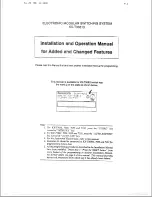
–––––––––––––––––––––––––––––––––––––––––––––––––––––––––––––––––––––––––––––––––––
Conventions
ix
Conventions
Letters in [brackets] represent buttons which have Directory Numbers on them. For example:
➤
The left column gives
you single or
numbered steps that
you need to perform a
procedure. These
steps apply to both
mouse or keyboard
use.
The right column gives the immediate result of your action.
This column also includes additional notes and comments.
[PDN]
represents a Primary Directory Number (also known as an Extension
Number for your telephone.
[SDN]
represents a Secondary appearance of a [PDN]. A [PDN] which appears on
another telephone is considered an [SDN].
[PhDN]
represents a Phantom Directory Number button (an additional Directory
Number).
[DN]
represents a Directory Number button (also known as an Extension or
Intercom Number). Whenever [DN] is used in this guide, it means the user
can use any [PDN], [SDN], or [PhDN].
[DSS]
represents the directory number of another station which is accessed from a
DADM or DSS Console when this button is pressed.
represents buttons on a telephone.
~
means “through”.
+
is used for multiple key entries.
➤
denotes the step in a one-step procedure.












































